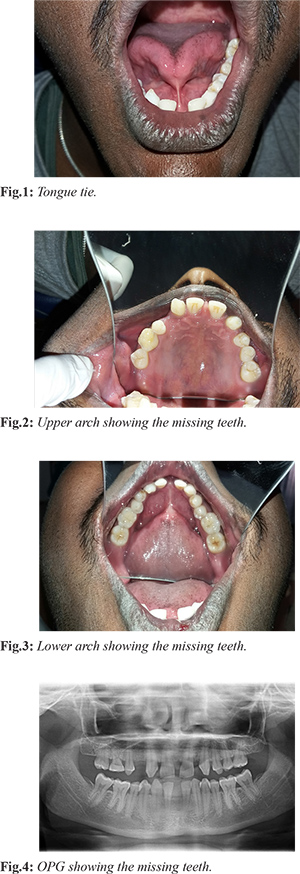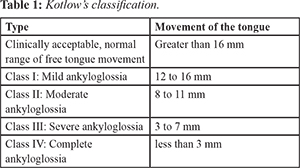6go6ckt5b8|3000F7576AC3|Tab_Articles|Fulltext|0xf1ff64da24000000f106000001000b00
6go6ckt5b5idvals|889
6go6ckt5b5|2000F757Tab_Articles|Fulltext
Introduction
Ankyloglossia is restriction of tongue movement due to congenital abnormality in the lingual frenum. Ankyloglossia may be syndrome associated, but commonly it has a non-syndromic presentation with an incidence of upto 10%. Congenital absence of permanent teeth can present as hypodontia, usually missing 1 or 2 permanent teeth, or oligodontia/partial anodontia that is the congenital absence of more than six teeth. In our case report, the patient had seven missing permanent excluding the third molars.
Case Report
A 26 year old male patient presented with complains of sensitivity in the upper right back tooth since month and spacing between teeth since 10 years. This was the patient’s first dental visit. Family and medical history was non-contributory. On intra-oral examination patient was unable to place the tongue forward because of short lingual frenum [Fig.1]. The body of the tongue could form lateral movements but not the tip of the tongue. The lingual frenum was attached little posterior to the tip of tongue and just below the ridge. Hard tissue examination revealed missing permanent teeth 13, 15, 17, 23, 27, 31, 41 [Fig.2,3], cervical abrasion in relation to retained 55. Based on clinical examination a provisional diagnosis of partial anadontia with class III ankyloglossia was given. On orthopantomogram (OPG), there were missing 13, 15, 17, 23, 27, 31, 41 [Fig.4]. Based on these findings, the final diagnosis of partial anadontia with class III ankyloglossia was made. The patient was advised frenuloplasty to relieve tongue tie, restoration of 55, prosthesis in relation to 13, 17, 23, 27, 31, 41.

Discussion
Anodontia is a rare genetic disorder characterized by the congenital absence of all primary or permanent teeth. Anodontia is usually part of a syndrome and seldom occurs as an isolated entity. Congenital absence of permanent teeth can present as hypodontia usually missing one or two permanent teeth, or oligodontia/partial anodontia that is the congenital absence of more than six teeths. It may involve both the dentitions or sometimes only the permanent dentition is affected. The actual cause of this ailment remains a mystery as yet. However, it is suspected to be a genetic abnormality that springs from familial traits. Oligodontia can occur in association with various genetic syndromes, such as ectodermal dysplasia, incontinentia pigmenti, Down syndrome, Rieger syndrome, Wolf-Hirschhorn syndrome, Van der Woude syndrome, ectrodactyly-ectodermal dysplasia-clefting syndrome, Cleft lip palate, ectodermal dysplasia syndrome, oral facial digital syndrome type I, Witkop tooth-nail syndrome, Fried syndrome, hair-nail-skin-teeth dysplasias, Hirschhorn syndrome, hemi-facial microsomia and recessive incisor hypodontia. Treatment options are prosthetic replacement or implants with respect to the missing teeth.
Ankyloglossia or tongue-tie is the result of a short, tight, lingual frenulum causing difficulty in speech articulation due to limitation in tongue movement. Wallace defined tongue-tie as “a condition in which the tip of the tongue cannot be protruded beyond the lower incisor teeth because of a short frenulum linguae, often containing scar tissue.” The prevalence of ankyloglossia reported in the literature varies from 0.1% to 10.7%. There is some evidence that ankyloglossia can be a genetically transmissible pathology [
3]. It is unknown which genetic components regulate the phenotype and penetrance in the patients affected.
The possible sequlae of ankyloglossia remain controversial, and the range of suggested complications is great. Among the suggestions found in the literature are: lower incisor deformity; gingival recession; and malocclusions [
5]. Ankyloglossia was also found associated in cases with some rare syndromes such as X-linked cleft palate syndrome, Kindler syndrome, van der Woude syndrome, and Opitz syndrome [
2]. Nevertheless, most ankyloglossias are observed in persons without any other congenital anomalies or diseases. Speech problems can occur when there is limited mobility of the tongue due to ankyloglossia. Criteria for establishing the diagnosis of ankyloglossia ranges from simple (e.g., the tip of the tongue cannot be protruded beyond the lower incisor teeth) to more complex and cumbersome ratios of various lingual dimensions. The use of tongue protrusion and elevation measurements assists in the clinical assessment of ankyloglossia and provides an effective means for documenting pre-operative and post-operative lingual mobility [
6].
The ankyloglossia can be classified into four classes based on Kotlow's assessment [
1] as shown in
[Table 1]. Less than 3 mm, i.e. class III and IV tongue-tie category should be given special consideration because they severely restrict the tongue's movement. If there is no feeding difficulty in the infant, it would be best to have a wait-and-see approach since the frenulum naturally recedes during the process of an individual's growth between six months and six years of age. After completion of growth and also during infancy, if the individuals have a history of speech, feeding, or mechanical/social difficulties surgical intervention should be carried out. Therefore, surgery should be considered at any age depending on the patient's history of speech, feeding, or mechanical/social difficulties. Surgical techniques for the therapy of tongue-ties can be classified into three procedures. Frenotomy is a simple cutting of the frenulum. Frenectomy is defined as complete excision, i.e., removal of the whole frenulum. Frenuloplasty involves various methods to release the tongue-tie and correct the anatomic situation [
4]. To best of our knowledge, only one case of partial anodontia with ankyloglossia has been reported in literature [
7].

Conclusion
For effective management proper clinical guidelines are mandatory. This case report offer guidelines which can be used by an oral physician for diagnosis and treatment of a tongue restriction resulting from ankyloglossia and partial anodontia.
Contributors: RJ has contributed towards data acquisition, manuscript preparation and editing. SBHR has contributed towards the article concept, design and manuscript review. RJ will act as study guarantor. Both authors approved the final version of this manuscript.
Funding: None; Competing interests: None stated.
References
- Bhattad MS, Baliga MS, Kriplani R. Clinical Guidelines and management of ankyloglossia with 1 year followup: Report of 3 cases, case reports in Dentistry. 2013, Article ID 185803.
- Chandrashekar L, Kashinath KR, Suhas S. Labial ankyloglossia associated with oligodontia: A case report. J Dent (Tehran). 2014;11:481-484.
- Darshan HE, Pavithra PM. Tongue tie: from confusion to clarity-a review,” International Journal of Dental Clinics. 2011;3:48-51.
- Chaubal TV, Dixit MB. Ankyloglossia and iIts management. Journal of Indian Society of Periodontology. 2011;15:270-272.
- Kupietzky A, Botzer. Ankyloglossia in infant and young child: Clinical suggestions for diagnosis and management. Pediatric Dentistry. 2005;40:40-46.
- Aldebei OM. Tongue tie (Ankyloglossia). Glob J Oto. 2016;1(4): GJO.MS.ID.555570 (2016).
- L. Chandrashekar, Kashinath KR, Suhas S. Labial ankyloglossia associated with oligodontia: A Case Report. J Dent (Tehran). 2014;11:481-484.